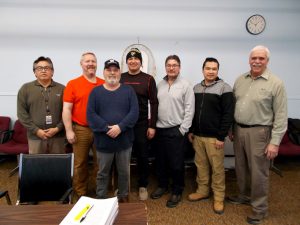Energy conservation initiatives have reduced some of the cost premium that is an inescapable fact of living in Canada’s north, while supporting skills development that make health care operations more self-reliant in five James Bay communities. The Canadian Coalition for Green Health Care and the Weeneebayko Area Health Authority (WAHA) — providing health care services for a largely First Nations clientele in the northern Ontario communities of Attawapiskat, Kashechewan, Fort Albany, Moose Factory and Moosonee — joined forces in 2016 to assess energy use in WAHA facilities and find savings through retrofits, operational adjustments and promoting a conservation mindset.
As part of that effort, the first group of certified building operators to graduate from a training program in a remote northern community are now applying their enhanced energy management knowledge in the facilities where they work. Their instructor, JJ Knott, who heads up HealthCare Energy Leaders Ontario (HELO), notes that other kinds of efficiencies have also been achieved through the development of in-house expertise.
“WAHA’s First Nations facility staff are now confident to tackle a much broader spectrum of building maintenance and retrofit tasks,” he reports. “Their previous reliance upon expensive fly-in technical support has been replaced by enthusiasm, competence and a newfound determination to make their buildings more energy-efficient and climate-change-ready.”
Capacity building is all about enabling and embedding this kind of technical knowledge within an organization. Energy awareness supports energy-conserving behaviour. In turn, that helps to ensure energy retrofit and management projects achieve maximum payback and steady savings over time. Training facility staff to be energy champions creates role models within the organization who then influence others to become involved in improving the environmental stewardship and climate change resiliency of their health care infrastructure.
Ontario’s Independent Electricity System Operator (IESO) provided funding support for the competency-based building operator certification (BOC) training. Through the course, facilities personnel got the opportunity to improve their technical expertise and job skills in a number of core areas including: energy-efficient operation of building HVAC systems; measuring and benchmarking energy performance; efficient lighting and HVAC controls fundamentals; indoor environmental quality; common opportunities for low-cost operational improvements; facility electrical systems; and operation and maintenance practices for sustainable buildings.
As a result, WAHA staff have taken a more proactive role in project design and application. “The training has led to a new sense of pride and ownership,” Knott maintains.

BOC graduates, Mervin Weistche, Marcel Brazeau, Jean Arsenault, Sterling Trapper, Paul Corston and Wade Rickard with instructor, JJ Knott
Graduates’ assessments of the program were similarly positive, with comments such as: “The BOC training has helped make me more aware of possible [energy] savings to be had and helped develop better maintenance strategies.” Others credited it with refining “knowledge of HVAC systems, how to properly maintain and upkeep buildings and showed me other options to use to solve issues” and “planning and coordination of annual maintenance of building systems”.
They’ve since applied that knowledge at the Weeneebayko Hospital where steam trap audits were completed and corrections were made to systems. Outside the hospital, condensate return lines from community housing steam distribution systems were re-designed, re-constructed, steam traced and re-insulated, contributing to a 40 per cent gain in condensate return to the boiler systems.
Other significant energy savings have come from installation of a new summer boiler at the Weeneebayko Hospital, which has reduced fuel consumption by 5 per cent. Improved R values from a window and door replacement project translated into an additional annual saving of 76,000 litres of fuel oil and 41,000 kWh of electricity. Lighting retrofits have cut electrical consumption a further 600,000 kWh annually, with a concomitant annual savings of $90,000.
A new energy and expense tracking system is a complementary investment in monitoring and verification that will help operations staff and facility administrators spot any anomalies in consumption that require attention. Purchasing policies have also been updated to prioritize energy efficiency, with an emphasis on ENERGY STAR, for the procurement of new equipment and design services, and consideration for re-use and recycling has been added to decision-making criteria.
The Canadian Institute of Energy Training (CIET), the governing body for building operator certification, commends the initiative and foresees future collaboration with the Canadian Coalition for Green Health Care.
“We were excited when the Coalition requested our help in developing and deploying the BOC course in a remote northern First Nations community. It was a first for us,” recalls Mathieu Côte, CIET’s executive director. “We are very pleased with the results of having knowledgeable and empowered building operators now in the James Bay communities.”
Kent Waddington is communications director for the Canadian Coalition for Green Health Care.






